Baron
Author: Franz Gaudoit
Publisher: Tilsit
Year: 2006
review by

| x |
|
|
|
|
|
|
|
|
|
|
|
|
|
|
|
|
|
|
|
|
|
|
|
|
|
|
|
|
|
|
|
|
|
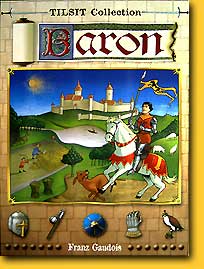 |
| We have just been knighted, and we aim to build a kingdom of such beauty that our competitors will envy us, and the damsels will swoon in admiration. Two to five players embark on this ambitious quest in the gam Baron. The beauty of our kingdom is translated to honour points, and the player who manages to collect most of these may call himself the winner. |
| The game board consists of one hexagonal land tile at the beginning of the game, and as the game progresses, more tiles are added. There are nine different types of land tiles, ranging from –2 points to +3 points. All players receive 2 to 5 donjons (towers) in their players colour, depending on the number of players. Everybody receives one meadow tile (value 0) and one tile with value 1. |
|
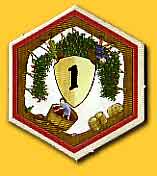 |
|
| x |
|
|
|
|
|
|
|
|
|
|
|
|
|
|
|
|
|
|
|
|
|
|
|
|
|
|
|
|
|
|
|
|
|
|
|
|
|
|
|
|
|
|
|
|
|
At the beginning of his turn, a player draws a tile from a display of three tiles. The first tile is for free, the tile in the second position costs one honour point, and the tile at the back costs three honour points. Subsequently, the player has to place one tile. This tile has to be connected to the game board on at least one side, and two identical tiles cannot be adjacent, except for meadows. A player concludes his turn by placing a tower on a free meadow, if he wishes. These towers constitute the core of the game. As soon as a tower is surrounded by tiles on all six sides, the owner of the tower, which represents a knight, tries to consolidate a barony.
First, it is determined whether the six tiles that surround the knight (partly) overlap with a barony of another player. If not, the knight doesn’t have to fight, and he automatically becomes a baron. The tower is put upside-down, to indicate that the knight is now a baron. The value of the six tiles that constitute his barony are added up, and this total is added to his honour points. |
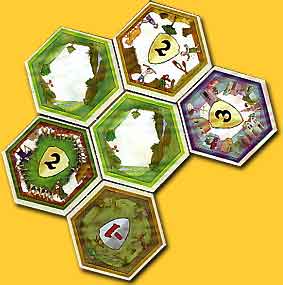 |
| x |
|
|
|
|
|
|
|
|
|
|
|
|
|
|
|
|
|
|
|
|
|
|
|
|
|
|
|
|
|
|
|
|
|
|
|
|
|
|
|
|
|
|
|
|
|
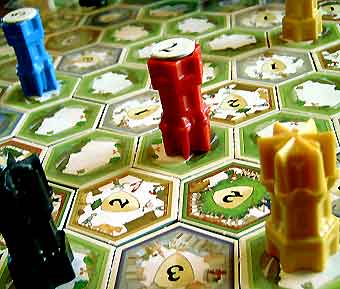 |
|
To remind players of the value of a barony, a power token indicating the value of the barony is placed on top of the tower. If the six tiles of the barony do overlap with a barony of another player, the baron and the knight start a fight. All tiles that are part of both baronies are covered with special combat tokens. These are the tiles they are fighting about. The barony with the highest total value on the remaining tiles of his barony wins the combat. If the old baron was the strongest, the knight is removed from the board. This has no further consequences for the scores of both players. |
| However, if the knight was stronger than the baron, the baron is chased away, and he receives minus points for his defeat. The number of minus points equals the value of the tiles that were part of both baronies. The victorious knight is turned over to its baron-side, and the points of his new barony are scored as described previously. |
|
 |
Knights/barons that have been removed from the board can be placed again by their owners later in the game. The game ends when all land tiles have been placed. The knights that are already on the board, but are not surrounded yet by six tiles, make one last-minute attempt to consolidate a barony. If the tiles of their barony overlap with those of other players, combat is resolved as usual. The points that can be scored in this final phase are half their normal value. The baron with the highest score wins the game. |
| x |
|
|
|
|
|
|
|
|
|
|
|
|
|
|
|
|
|
|
|
|
|
|
|
|
|
|
|
|
|
|
|
|
|
|
|
|
|
|
|
|
|
|
|
|
|
 |
|
|
|
|
|
|
|
|
|
|
|
|
|
|
|
|
|
|
|
|
|
|
|
|
|
|
|
|
|
|
|
|
|
|
|
|
|
|
|
|
|
|
It may have become clear that basically we are dealing with an abstract game. However, the game is flavoured with nicely illustrated tiles that give a nice touch to the game, and also the honour points track is covered with storytelling illustrations: a maiden tosses her white handkerchief from the balcony, a fire breathing dragon is pierced by a valorous knight, and a young lad is just being knighted by King Arthur. This definitely adds some atmosphere to the game.
A nice element is that the first tile from the display can be taken for free, but the other two must be paid for with honour points. Because a player does not want his opponent to get that ‘three’, or because he fears he might have questionable intentions with the ‘minus two’, it may be worth the price to pay for a tile before someone else can get it for free.
|
|
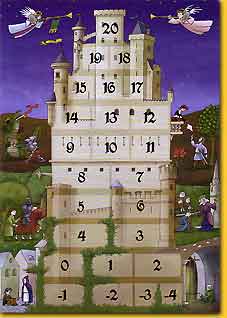 |
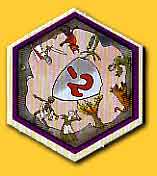 |
Because of the limited number of towers a player receives, it becomes clear that the idea is to consolidate a barony, get chased away by your opponents without loosing too many points, and reuse the tower for the same purpose a couple of times. If one builds a barony at the beginning of the game that is so strong that no one is able to chase you away, that tower is stuck there for the remainder of the game. Because a player has only two towers in a five-player game, he cannot afford this. But if the inevitable and perhaps desirable happens and the player does get chased away, he does not want to lose almost as many points as he scored when he built the barony. |
| But how to achieve this? A tower can be placed only on a meadow; by checking out where the meadows are in the vicinity of your barony, it can be estimated where any opposing knights could be placed, how many points they would score, and how many points a player would lose if he is chased away (the minus points are determined by the value of the overlapping tiles of the fighting baronies). This type of analysis can help to determine whether a barony has enough potential to be consolidated in the first place. |
|
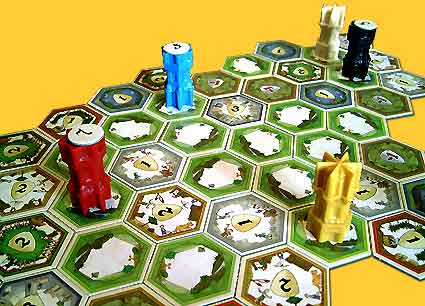 |
| x |
|
|
|
|
|
|
|
|
|
|
|
|
|
|
|
|
|
|
|
|
|
|
|
|
|
|
|
|
|
|
|
|
|
|
Further, it is best to spread the towers evenly over the board. A player can never enter combat with himself: multiple baronies of the same colour peacefully exist next to each other. The disadvantage of this is that these baronies cover each other’s backs, which diminishes the chance that a player is even chased away by an opposing baron.
Because a player is dependent on his opponents to kick him off the board every now and then, gameplay may vary with each different players group. A strategy that leads to immediate victory in one group can lead to imminent destruction in an other. This however keeps the game fresh. Baron is a challenging, counting game that involves a degree of puzzling. It is a game that players can really improve at when they have been playing it a couple of times.
© 2006 Barbara van Vugt
Baron, Franz Gaudoit, Tilsit, 2006 - 2 to 5 players, 12 years and up, 75 minutes
|
|
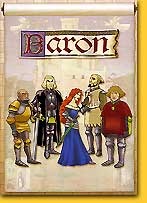 |
  |
|
|
|
|
|
|
|
|
|
|
|
|
|
|
|
|
|
|
|
|
|
|
|
|
|
|
|
|
|
|
|
|
|
|
|
|
|
|
|
|
|
  |
|
|
|
|
|
|
|
|
|
|
|
|
|
|
|
|
|
|
|
|
|
|
|
|
|
|
|
|
|
|
|
|
|
|
|
|
|
|
|
|
|
  |
|
|
|
|
|
|
|
|
|
|
|
|
|
|
|
|
|
|
|
|
|
|
|
|
|
|
|
|
|
|
|
|
|
|
|
|
|
|
|
|
|
  |
|
|
|
|
|
|
|
|
|
|
|
|
|
|
|
|
|
|
|
|
|
|
|
|
|
|
|
|
|
|
|
|
|
|
|
|
|
|
|
|
|
| x |
|
|
|
|
|
|
|
|
|
|
|
|
|
|
|
|
|
|
|
|
|
|
|
|
|
|
|
|
|
|
|
|
|
|
|
|
|
|
|
|
|
|
|
|
|
| x |
|
|
|
|
|
|
|
|
|
|
|
|
|
|
|
|
|
|
|
|
|
|
|
|
|
|
|
|
|
|
|
|
|
|
|
|
|
|
|
|
|
|
|
|
|
 |
|
|
|
|
|
|
|
|
|
|
|
|
|
|
|
|
|
|
|
|
|
|
|
|
|
|
|
|
|
|
|
|
|
|
|
|
|
|
|
|
|
 |
|
|
|
|
|
|
|
|
|
|
|
|
|
|
|
|
|
|
|
|
|
|
|
|
|
|
|
|
|
|
|
|
|
|
|
|
|
|
|
|
|
| x |
|
|
|
|
|
|
|
|
|
|
|
|
|
|
|
|
|
|
|
|
|
|
|
|
|
|
|
|
|
|
|
|
|
|
|
|
|
|
|
|
|
|
|
|
|
 |
|
|
|
|
|
|
|
|
|
|
|
|
|
|
|
|
|
|
|
|
|
|
|
|
|
|
|
|
|
|
|
|
|
 |
|
|
|
|
|
|
|
|
|
|
|
|
|
|
|
|
|
|
|
|
|
|
|
|
|
|
|
|
|
|
|
|
|
|
|